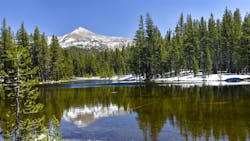PG&E Completes Land Conservation Commitment
Pacific Gas and Electric Company (PG&E) joined with federal, state, local, and tribal government officials and other partners at Pepperwood Preserve celebrated the fulfillment of its Land Conservation Commitment, achieving permanent protection of approximately 140,000 acres of PG&E-owned watershed lands. These lands are now conserved for Californians, protecting habitat for fish, wildlife and plants; open space and cultural resources; outdoor recreation by the general public; and sustainable forestry and agricultural uses.
PG&E completed its unprecedented Land Conservation Commitment (or LCC) over about 20 years, developing unique conservation agreements and partnerships with private conservation groups, Native American tribal organizations and the California Department of Forestry and Fire Protection (CAL FIRE). PG&E and its LCC partners will protect the lands in perpetuity for the benefit, education and enjoyment of the public.
Further demonstrating its commitment to the planet, PG&E is also helping to build more resilient forests to reduce wildfire risk through new pilot projects underway in a handful of communities. The event was held at Pepperwood Preserve in Santa Rosa, the site of PG&E's first 100% renewable remote electric grid, an innovation in wildfire mitigation.
"We're grateful for the partnerships formed over the past two decades to protect these lands for the benefit and enjoyment of Californians and its visitors. We're extremely proud knowing that these beautiful outdoor spaces will continue to thrive and survive for future generations," said Carla Peterman, Executive Vice President, Corporate Affairs and Chief Sustainability Officer for PG&E Corporation.
Land Conservation Commitment
Arising from its 2003 bankruptcy settlement, PG&E's LCC permanently protects approximately 140,000 acres of forests, wetlands and meadows across the Sierra Nevada and Cascade ranges by granting conservation easements to local land trusts and donating land not needed for PG&E operations. Some 40,000 acres were transferred to local organizations while PG&E retains ownership of 100,000 acres.
Additionally, PG&E's commitment included $30 million of dedicated funding for youth investment and $70 million for land conservation.
Among the land conservation transfers:
- A 62-acre parcel located on the shores of Lake Valley Reservoir in Placer County, known as the Sky Mountain Outdoor Education Center, to the San Joaquin Office of Education to serve as a camp for underserved youth. Wildlife Heritage Foundation maintains the conservation easement.
- Nearly 15,000 acres of land in Shasta, Nevada and Placer counties to CAL FIRE for forest research, restoration and public recreation. The land is managed in partnership with the Shasta Land Trust, Bear Yuba Land Trust and Placer Land Trust — which hold conservation easements on the properties ensuring that the scenic, open space, forest, wildlife habitat, recreation, and historic and cultural values are protected for the benefit of all Californians.
- 879 acres of property to the Potter Valley Tribe in Mendocino County (and a conservation easement over the lands to Mendocino Land Trust) along the Eel River, including forested land and much of Trout Creek Watershed, allowing the tribe to own ancestral land for traditional land management and to provide outdoor activities for youth and educate others about the history and culture of Native American people.
Potter Valley Tribal Chair Salvador Rosales explained why receiving the transfer of land within the tribe's ancestral range is so significant.
"It's the freedom to exercise our tribal and cultural traditions, including hunting and gathering, without looking over our shoulders," said Rosales. "The excitement is being able to take our younger generation, our children, and have them more or less identify their new land and say that it's ours."
Rosales said plans for the property include expanding cultural educational programs for youth, including camping and vocational training.
Partnering for Resilient Forests
A critical part of protecting California's land and communities is making forests more resilient to wildfires and other climate impacts.
"Climate change is not slowing down, and neither can we. We must look toward the future and focus on improving the health of our forests to decrease wildfire risk and make our communities safer," said Peterman.
PG&E has launched local pilot projects with various partners to reduce wildfire risk by better managing forest fuels while supporting community needs.
Among the pilot projects underway:
- In Tuolumne County, working with American Forest Foundation and the county to restore forest health on private lands through targeted forest treatments.
- In Butte County, partnering with the Butte County Fire Safe Council, California Department of Water Resources and CAL FIRE to treat PG&E-owned and adjacent land in high-fire risk locations.
- In Sonoma County, working with the Northern Sonoma County Fire Foundation to support fuel reduction around roadside rights-of-way to improve safety on a key evacuation route.
All of the projects will benefit customers, the state and forest ecosystems.
Pepperwood Preserve Remote Grid Innovation
One way to build forest resilience is through technology and innovation. Pepperwood Preserve, which hosted the LCC event, is home to PG&E's first fully renewable remote grid, deployed last year in November, and part of PG&E's growing fleet of standalone power systems aimed at reducing wildfire risk.
As described in PG&E's Wildfire Mitigation Plan, remote grids provide utility service using standalone local energy resources, replacing long distribution lines in remote and high fire-risk areas with an innovative and safer option.
Pepperwood Preserve, set in the idyllic Mayacamas Mountains within the traditional homeland of the Wappo people, is a living laboratory for crafting climate and wildfire solutions grounded in conservation science. The 3,200-acre property is an important refuge for more than 900 species of native plants and wildlife and was directly impacted by both the Tubbs and Kincade Fires.
Pepperwood is a hub for climate monitoring, applied research, science education, and wildfire resilience demonstration projects, such as the now extensive ALERTWildfire camera network. The site's remote grid powers Pepperwood's Bechtel House, which houses overnight visitors.
